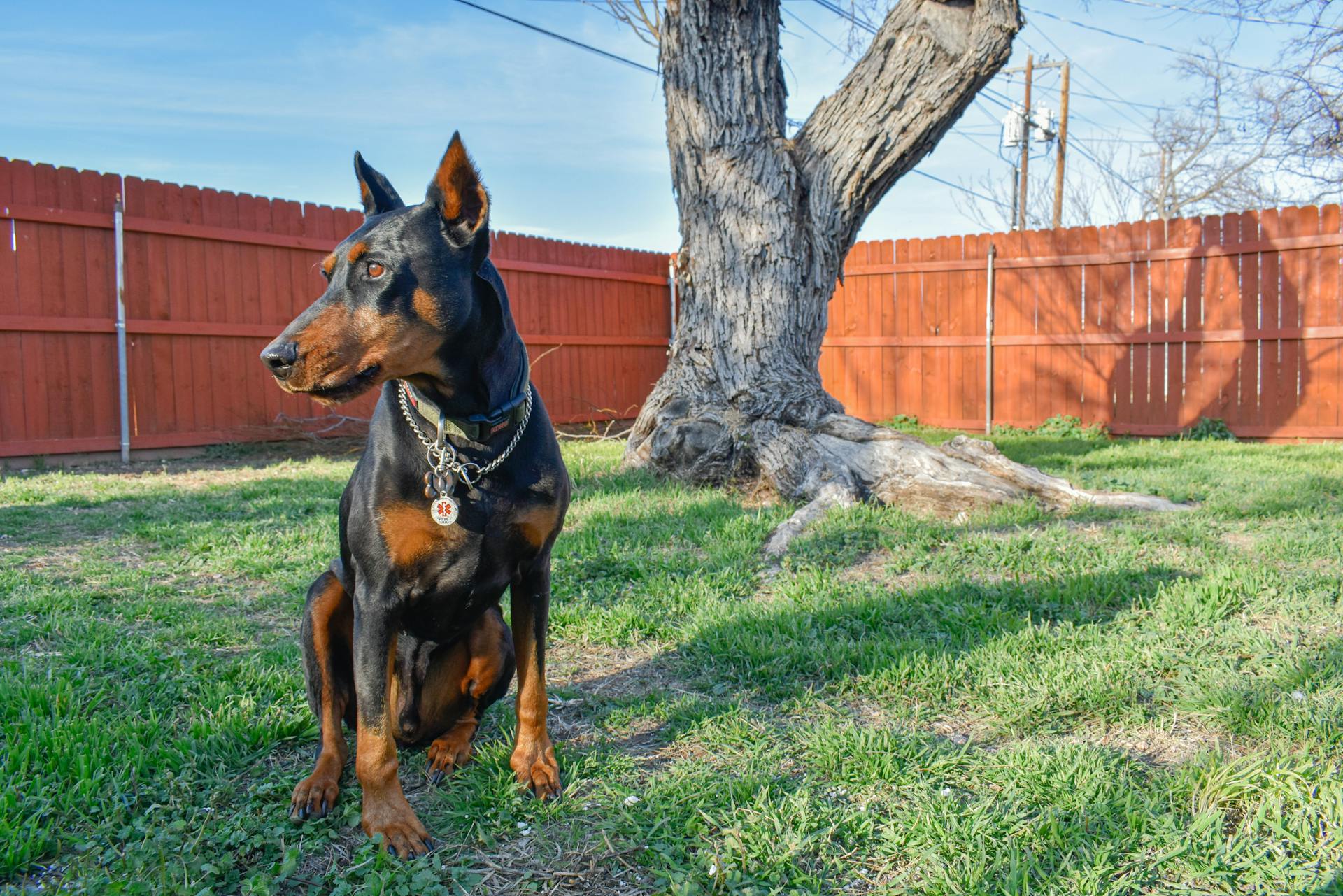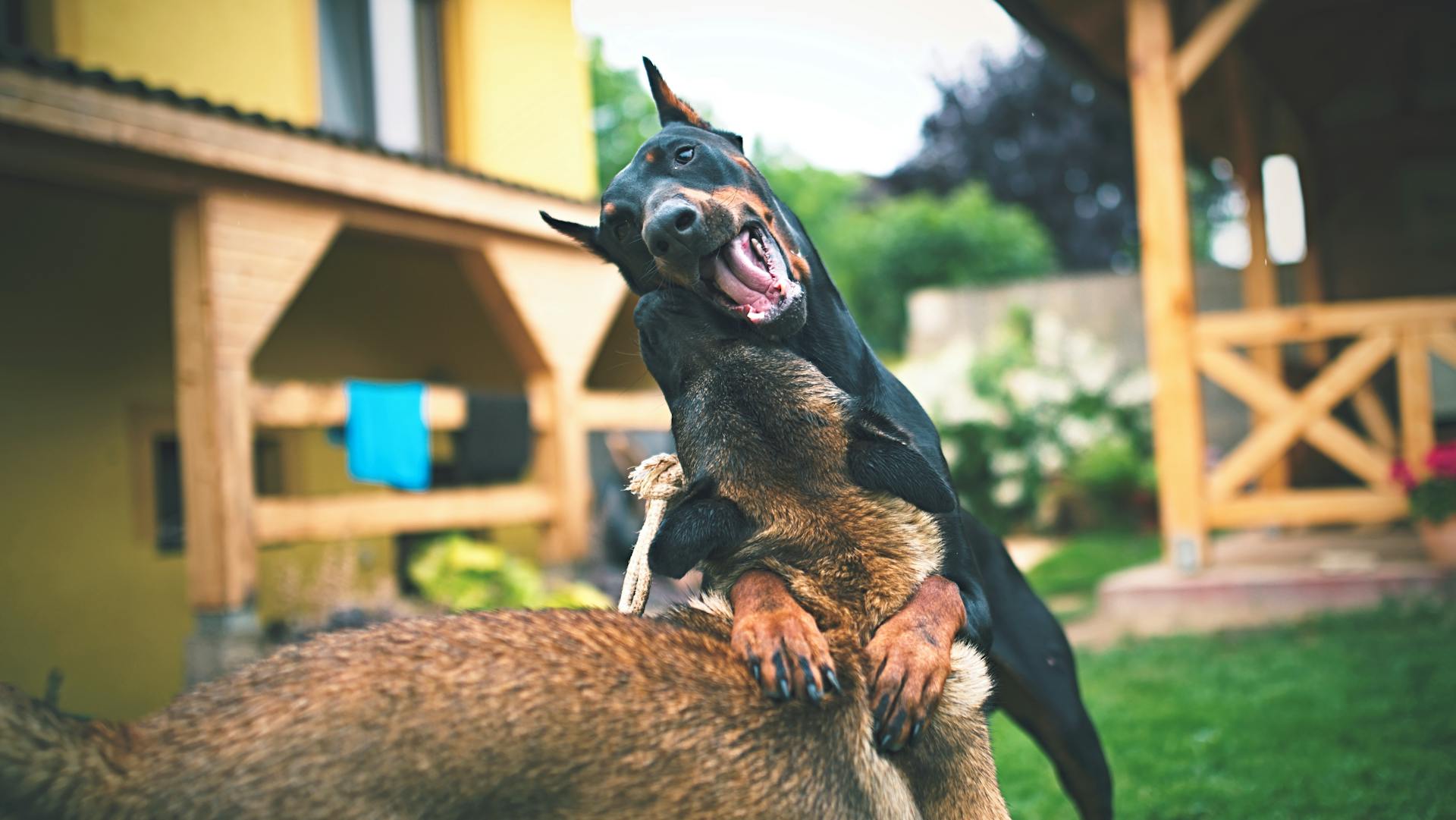
Doberman prey drive is a complex behavior that's deeply rooted in their history and instincts. As a breed developed for guarding and hunting, Dobermans have an innate drive to chase and catch small animals.
Their prey drive is linked to their high prey drive index, which is a measure of their instinct to chase and catch prey. This index is higher in Dobermans than in many other breeds.
Doberman owners often notice their dogs' intense focus on small animals, even if it's just a toy or a ball. This focus is a sign of their prey drive at work.
Dobermans are bred to be energetic and athletic, which makes them well-suited for activities that challenge their prey drive, such as agility and flyball.
A unique perspective: Are Rottweilers and Dobermans Related
Understanding Prey Drive
Dogs with strong prey drive can become fixated on small animals, unable to take their eyes off them, even from a distance. This can be a challenge for owners who want to take their dogs for walks without encountering unwanted excitement.
Signs of high excitement in dogs with strong prey drive include upright and tense posture, teeth chattering, and drooling. If you've ever seen a dog in this state, you know it's not a pretty sight!
Some common behaviors exhibited by dogs with strong prey drive include stalking, tracking, lunging, and chasing small animals. In extreme cases, they may even hover above or over the shoulder of a small animal.
What Is a Drive?
A drive is a strong instinctual urge that drives a dog's behavior. Prey drive, in particular, is a common drive found in many breeds.
Some breeds, especially working, hunting, and herding breeds, have a higher predatory chase drive than others. This drive is a natural behavior left over from their wolf ancestry.
Chasing is fun for dogs and triggers the pleasure centers of their brains. It's a reflex-like response that can be triggered by the movement of "prey".
Dogs with strong prey drive may display negative behaviors such as chasing, hunting, biting, or killing cats and small animals. They may also focus on and stalk other animals, or chase cars, bikes, skateboards, or other moving objects.
A dog's inability to focus on anything but moving things is a sign of a high prey drive. This can be a problem if it leads to inappropriate behaviors.
Reducing or Controlling Prey Drive
Reducing or controlling prey drive in your dog requires a combination of training, safety precautions, and understanding their instincts. Many dogs can be engaged with play and games like fetch, which provides a healthy outlet for their prey drive.
Training is essential to help your dog understand what's expected of them. Start training early and get your puppy well-socialized before their high prey drive kicks in. This will help them learn to respond to commands and behave in the presence of other animals.
Consider reading: Doberman Pinscher Training
Play impulse control games and predation substitute games to help your dog learn to focus on you instead of their prey drive. These games can be as simple as hiding treats or toys around the house or yard. Tire your dog out with various activities throughout the day, such as swimming, running, hiking, or playing fetch.
Using a leash when taking your dog on walks is crucial to maintain control over them. Keep your dog in a fenced yard to prevent them from running off and causing harm to themselves or others. Never leave your dog unsupervised with children or smaller animals, as this can lead to unfortunate situations.
Here are some key tips to keep in mind:
- Train your dog to have a strong recall so that they know to come to you when called.
- Give puppies lots of different toys to play with to keep them engaged and stimulated.
- Avoid reprimanding your dog and focus on getting their attention with treats before they respond to "prey."
Can High-Drive Dogs Live with Cats?
Most dogs with high prey drives can live with cats if they're introduced to them slowly and from a young age. It's a good idea to introduce them when they're young, as this can help them get used to each other's presence.
If you have an older dog with a high prey drive, it's not recommended to bring a new cat into the home. This is because the environment may not be safe for the cat.
The key to a successful introduction is to take the process nice and slow. Rushing through it can be detrimental to the relationship between the dog and cat.
Keep your dog and cat separated by a closed door at first, so they can familiarize themselves with each other's smell. This is an important step in helping them get used to each other.
Start to feed each pet near each other but not in eyesight. This will help them associate good things with the other pet's smell, which is a crucial step in building a harmonious relationship.
Face-to-face interactions should be done in a neutral area, and it's essential to keep your dog on a leash to maintain control. Keep the interactions short but frequent to avoid overwhelming the dog.
If your dog wants to chase a cat, assume that they might one day catch it, even if they seem docile. This is a crucial point to remember when introducing a high-drive dog to a cat.
Additional reading: How to Keep E Collar on Cat
Training and Management
Training and management of your Doberman's prey drive is crucial to prevent unwanted behavior. It's essential to start training early and get your puppy well-socialized before their high prey drive kicks in.
To strengthen your dog's recall, train them to respond to commands and play impulse control games. This will help them understand that coming to you is more rewarding than chasing a rabbit or squirrel.
Tiring your dog out with various activities like swimming, running, hiking, and playing fetch can also help manage their prey drive. Make sure to give them plenty of toys to play with and avoid reprimanding them when they exhibit prey drive behavior.
Here are some essential tips to keep in mind:
- Train your dog to have a strong recall.
- Play impulse control games and predation substitute games.
- Tire your dog out with various activities.
- Give puppies lots of different toys to play with.
- Avoid reprimanding your dog.
- Keep your dog in a fenced yard and use a leash when taking them on walks.
How to Train a Dog
Training a dog requires patience, consistency, and positive reinforcement. Start training early and get your puppy well-socialized before their high prey drive kicks in.
To begin, focus on basic obedience commands like recall, which means teaching your dog to come to you when called. Training your dog to respond to commands is crucial, especially when they spot a rabbit or squirrel.
You can also engage your dog in play and games like fetch, which provides a healthy outlet for their instincts. Play impulse control games and predation substitute games to help them develop self-control.
Tire your dog out by doing various activities with them throughout the day, such as swimming, running, hiking, or cycling while they run next to you on a leash. This will help reduce their energy levels and make them less likely to chase prey.
Here are some tips to help you manage your dog's prey drive:
- Train your dog to have a strong recall
- Play impulse control games and predation substitute games
- Tire your dog out with various activities
- Give puppies lots of different toys to play with
- Monitor their behavior and reactions to know when to step in
- Keep your dog in a fenced yard and use a leash on walks
- Never leave your dog unsupervised with children or smaller animals
Need Help with Dogs?
Dogs can get overexcited when they see a ball flying through the air, but it's a great way to channel that energy into a fun game of fetch.
You're right, a ball versus a moving small animal is a big difference, and it's essential to consider your dog's prey drive when training them.
Some dogs have a strong instinct to chase small animals, which can be a challenge to manage, especially if they're not well-trained.
In fact, a dog's prey drive can be a great asset in training, but it requires careful management and redirection to prevent unwanted behaviors.
If your dog gets overexcited when seeing a ball, try using a slower-moving toy or a treat to help them calm down and focus on the task at hand.
With patience and practice, you can teach your dog to channel their energy into a fun and rewarding game of fetch.
Recall and Safety
Doberman prey drive can be a real challenge for owners.
Their strong instinct to chase small animals often leads to recall issues, especially if they're not properly trained.
In fact, some Doberman owners report that their dogs can be as far as 100 yards away before they even notice they're gone.
This is because Dobermans have a high prey drive, which means they're naturally inclined to pursue small animals at high speeds.
If you're experiencing recall issues with your Doberman, it's essential to establish a consistent recall command, such as "here" or "come."
Regular training sessions, even short ones, can help strengthen the bond between you and your dog, making recall easier.
Dobermans are intelligent and responsive to positive reinforcement, so use plenty of treats and praise to motivate them.
You might like: Do German Shepherds Have High Prey Drive
Dog Behavior and Lifestyle
Raising a Doberman with high prey drive requires early training and socialization. Start training your puppy as early as possible to help them understand what's expected of them.
It's essential to get your puppy well-socialized before their high prey drive kicks in. This will help them learn to respond to commands and behave in public.
You can tire your Doberman out by doing various activities with them throughout the day, such as swimming, running, hiking, or playing games like fetch and tug-of-war. This will help burn off excess energy and reduce the likelihood of them chasing after small animals.
Playing impulse control games and predation substitute games can also help redirect your Doberman's prey drive. These games can help them learn to focus on you instead of the temptation of chasing small animals.
A strong recall is crucial for any dog, especially those with high prey drive. Train your Doberman to respond to commands and come to you when called, even if they've spotted a rabbit or squirrel.
Suggestion: Activities for Dogs with High Prey Drive
Here are some activities you can do with your Doberman to help manage their prey drive:
- Swimming
- Running
- Hiking
- Playing fetch
- Playing tug-of-war
- Hide-and-seek
It's also essential to keep your Doberman in a fenced yard and use a leash when taking them on walks. This will help prevent them from running off and reduce the risk of them chasing after small animals.
Signs of Illness in Dogs
Dogs with strong prey drive can sometimes exhibit behaviors that might be mistaken for illness. Here are some signs to look out for.
A tense posture and stiff tail can be a sign of high excitement, but it can also be a sign of anxiety or stress, especially if your dog is panting heavily or avoiding eye contact.
Dogs with strong prey drive often exhibit high excitement when they see potential prey, which can be misinterpreted as illness. However, if your dog is consistently displaying these behaviors, it's essential to address the underlying cause.
Readers also liked: Dog with High Prey Drive
If your dog is experiencing high excitement due to prey drive, you may notice signs like teeth chattering and drooling, or quickening of movement. These symptoms can be intense and may be mistaken for illness.
Here are some common signs of high excitement in dogs with strong prey drive:
- Upright and tense posture
- Teeth chattering and drooling
- Quickening of movement
- Upright stiff tail that is wagging quickly
Keep in mind that these symptoms can be intense, but they are not necessarily indicative of illness.
Frequently Asked Questions
How do you deal with a dog with high prey drive?
To manage a dog with high prey drive, train your dog to "leave" unwanted items and practice recall to prevent them from running off after small animals. Consistent training and secure outdoor areas can also help minimize the risk of your dog chasing prey.
Sources
- https://www.foundanimals.org/control-dogs-predatory-chase-drive/
- https://www.leaveit.com.au/dog-lifestyle/what-is-dog-prey-drive-4-signs-of-prey-drive-how-to-control-it/
- https://www.dogster.com/dog-breeds/dogs-with-high-prey-drives
- https://hmdd.org/dobe-for-you/
- https://dogtrainingelite.com/manchester/professional-dog-trainers/doberman-training
Featured Images: pexels.com


